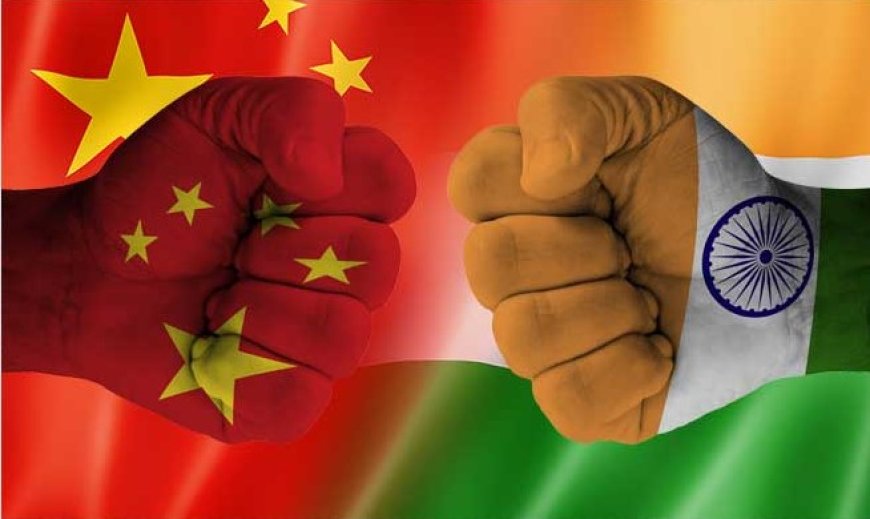“Navigating the Complexities: The Dynamics of India-China Relations”
In the vast expanse of geopolitical dynamics, few narratives captivate the world's attention quite like the intricate dance between India and China. These two ancient civilizations, each with a rich tapestry of history and culture, find themselves entwined in a relationship that is as complex as it is consequential. As we embark on a journey to unravel the nuances of this intricate interplay, it becomes evident that the India-China relationship is a narrative that transcends borders and reverberates on the global stage.

The Grand Tapestry of International Relations
The India-China border, also known as the Line of Actual Control (LAC), is a complex and contested boundary that stretches over 3,488 kilometers through some of the most challenging terrains in the Himalayan region. This border has been a source of historical tensions and conflicts between the two Asian giants.
The most significant conflict over the border occurred in 1962 when a brief but intense war broke out between India and China. The war resulted in China's victory, and a de facto border, known as the Line of Actual Control, was established. However, the border remained undefined, leading to ongoing disputes and tensions.
TABLE OF CONTENT:-
Introduction
Historical Context
Economic Ties
Diplomacy and Dialogue
Multilateral Engagement
Cultural Exchanges
Security Concerns
Environmental Cooperation
Conclusion
Introduction:
In the vast tapestry of international relations, few relationships are as intricate and consequential as that between India and China. These two Asian giants, with their rich histories and diverse cultures, share a complex dynamic that has evolved over centuries. In the contemporary geopolitical landscape, understanding the nuances of the India-China relationship is crucial, as it has far-reaching implications for regional and global stability.
Historical Context:
To comprehend the current state of affairs, it is essential to delve into the historical context of India-China relations. The two nations, each with a civilization dating back thousands of years, have coexisted and interacted through trade, cultural exchanges, and religious influences. However, historical territorial disputes, such as the Sino-Indian border conflict of 1962, have left a lasting impact on their relationship.
Economic Ties:
In recent decades, economic interdependence has emerged as a significant factor in shaping the India-China relationship. Both nations have witnessed remarkable economic growth, and their respective markets have become increasingly integrated. Trade agreements and collaborations in various sectors have fostered mutual economic benefits, turning the two countries into key players in the global economy.
However, the economic dimension of their relationship also introduces challenges. Trade imbalances, market access issues, and competition for resources can strain ties. Effectively managing these economic dynamics requires diplomatic finesse and strategic cooperation.
Diplomacy and Dialogue:
Diplomacy plays a pivotal role in maintaining stability between India and China. Regular high-level dialogues, such as the Strategic and Economic Dialogue, provide platforms for addressing concerns, building trust, and finding common ground on various issues. Engaging in open and transparent communication channels helps prevent misunderstandings and ensures that both nations are on the same page regarding their intentions and policies.
Multilateral Engagement:
Both India and China actively participate in various international forums and organizations, such as the BRICS (Brazil, Russia, India, China, South Africa) and the Shanghai Cooperation Organisation (SCO). Multilateral engagement provides an opportunity for collaboration on global challenges, fostering a sense of shared responsibility. It also allows the two nations to showcase leadership and contribute to the development of a multipolar world order.
Cultural Exchanges:
Cultural exchanges serve as a bridge between nations, fostering people-to-people connections and understanding. Programs promoting educational and artistic exchanges, as well as initiatives to celebrate shared cultural heritage, contribute to building a positive narrative. These interactions can help dispel stereotypes, narrow cultural gaps, and create a foundation for stronger ties.
Security Concerns:
Despite efforts to maintain stability, security concerns persist in the India-China relationship. The unresolved border issues, periodic military standoffs, and geopolitical rivalries in the region underscore the delicate nature of their ties. Both nations must navigate these challenges with a focus on conflict resolution, de-escalation mechanisms, and building mutual trust to ensure long-term stability.
Environmental Cooperation:
As the global community grapples with environmental challenges, India and China have a shared responsibility to address issues such as climate change and sustainable development. Collaborative efforts to invest in green technologies, reduce carbon emissions, and protect natural resources can not only benefit both nations but also contribute to global efforts to combat climate change.
Conclusion:
In conclusion, the India-China relationship is a multifaceted tapestry of history, economics, diplomacy, culture, and security. Navigating this complex dynamic requires a balanced approach that addresses both shared interests and divergent perspectives. By fostering open communication, engaging in constructive dialogue, and working together on common challenges, India and China can build a relationship that contributes to regional and global stability in the 21st century.




